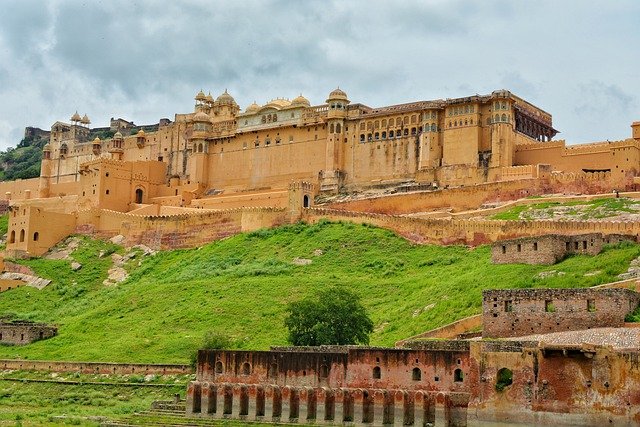The towns and places of eastern Rajasthan can be easily reached from Jaipur and Agra or Delhi (all stops along the Golden Triangle). For a deeper dive into the past, look up Alwar and Jaipur’s stunning palaces. The stunning forts of Tonk and Ranthambore.
Jantar Mantar:
In the vicinity close to City Palace is Jantar Mantar, the observatory built in 1728 by Jai Singh II in 1728 reminiscent of a series of strange gigantic sculptures. The observatory was designed to measure the heavens and the sky. We suggest you to choose the best suited tour package from eastern Rajasthan tour packages. And come to visit the best places like Jantar Mantar.
The name comes from the Sanskrit mantra yantra, which translates to “instrument of calculation”. In the year 2010, it was added to the list of Unesco World Heritage Sites. If you really want to learn as much about the mechanisms behind any of these instruments, hiring a local guide is strongly suggested.
Isarlat:
The skyline that runs through and in front of the City Palace is this unusual minaret, built during 1740 by his son Jai Singh II’s successor Iswari. The entryway lies at the back of the series of shops that surround the Chandpole Bazaar; access the bazaar through the alley 50 metres west of the minaret, or by the Atishpol entrance point, 150 metres east of the minaret.
Take the best Rajasthan tour packages, to get to explore every small to big things and places of eastern Rajasthan in the best ways.
You may stand at the top of the 43-meter-high minaret for spectacular views. Rather than fighting the invading Maratha army, Iswari was killed by a snakebite (at the Chandra Mahal). His 21 wives and concubines did the right thing and performed the Jauhar (ritual mass suicide through burning) at the funeral pyre.
Lohagarh:
The still-inhabited 18th-century Lohagarh, also known as the Iron Fort, was named for its strong defences. Although it’s a bit decrepit and abandoned, it’s impressive and is located in the middle of town, with a moat.
There’s a northern entry point located at Austdhatu (Eight-Metal) Gate – it is believed that the spikes on this gate were made out of eight different metals. It also has an entrance to the south, located in Lohiya Gate.
Maharaja Surajmal, the fort’s builder and the creator of Bharatpur and Bharatpur, built two towers well within walls. The Jawahar Burj and the Fateh Burj, to honour his triumphs against the Mughals and the British. The fort also houses three palaces that were once part of its perimeter, one of which houses an exhibit.
Bala Quila:
The fort is awe-inspiring and towers at the height of 300m over Alwar. With its fortifications encircling the sloping hills that form the eastern part of Alwar. The fort was constructed before the reign of Pratap Singh and is one of only a handful of forts within eastern Rajasthan constructed before the time of the Mughals, who made it an attack base to attack Ranthambore.
Mughal Emperors Babur and Akbar stayed here, and Prince Salim (later Jehangir, the Emperor) was exiled from Salim Mahal for over three months.
Sunehri Kothi, Tonk:
It is worth a look at this palace built in the 19th century, which is decorated with beautiful colored Belgium glass and inlay work and gilding. The building is decrepit, and amateurs have renovated it. Signing in at the tiny office near the entrance is necessary, and the guide will require the tip.
The Cenotaphs of Maharaja bakhtawar Singh:
The Maharaja Vinay Singh built this two-story tower, which sits on a sandstone platform, in commemoration of his father in 1815. When facing the palace, ascend the steps to the left to reach the cenotaph.
The name also includes the cenotaphs of Chhatri of Moosi Rani, named after one of the lovers of Bakhtawar Singh who committed self-immolation at his father’s funeral pyre. After this, she was elevated to wife status
Bangarh, Alwar:
Nearly 55 km south of Sariska and beyond the park sanctuary. And out into the countryside is this well-preserved, deserted and infamously haunted city. It was founded around 1631 under the leadership of Madho Singh.
Alwar had 10,000 houses but was abandoned and mysteriously deserted over 300 years ago. It is best reached via automobile (parking at Rs.50) or taxi. But it can be reached using a daily bus (Rs39) that travels through the sanctuary and to the close by Goloka village. Ensure you know when the bus leaves or you’re at risk of being trapped.
Ranthambore National Park:
The Jungle Book to life for yourself and your children as you journey through the Indian jungle by way of an exclusive Jeep safari. The most well-known resident of Ranthambore National Park is the stunning Bengal Tiger. And seeing one out in the wild can be thrilling for kids and adults.
If you’re not fortunate enough to see one, what you’re likely to be able to see is a multitude of peacocks, deer, monkeys and crocodiles. Who would not be thrilled about this? In between safaris, ascend the 10th century Ranthambore Fort on a guided tour. And feel like you’re in King Louie’s cave!

